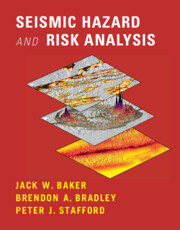Refine search
Actions for selected content:
2664 results in Civil and geotechnical engineering
2 - Review of Probability Theory
-
- Book:
- Structural and System Reliability
- Published online:
- 13 January 2022
- Print publication:
- 13 January 2022, pp 11-57
-
- Chapter
- Export citation
Dedication
-
- Book:
- Structural and System Reliability
- Published online:
- 13 January 2022
- Print publication:
- 13 January 2022, pp v-vi
-
- Chapter
- Export citation
Contents
-
- Book:
- Structural and System Reliability
- Published online:
- 13 January 2022
- Print publication:
- 13 January 2022, pp vii-xii
-
- Chapter
- Export citation
3 - Multivariate Distributions
-
- Book:
- Structural and System Reliability
- Published online:
- 13 January 2022
- Print publication:
- 13 January 2022, pp 58-92
-
- Chapter
- Export citation
8 - System Reliability
-
- Book:
- Structural and System Reliability
- Published online:
- 13 January 2022
- Print publication:
- 13 January 2022, pp 200-261
-
- Chapter
- Export citation
14 - Reliability-Based Design Optimization
-
- Book:
- Structural and System Reliability
- Published online:
- 13 January 2022
- Print publication:
- 13 January 2022, pp 493-522
-
- Chapter
- Export citation
Copyright page
-
- Book:
- Structural and System Reliability
- Published online:
- 13 January 2022
- Print publication:
- 13 January 2022, pp iv-iv
-
- Chapter
- Export citation
6 - The First-Order Reliability Method
-
- Book:
- Structural and System Reliability
- Published online:
- 13 January 2022
- Print publication:
- 13 January 2022, pp 135-184
-
- Chapter
- Export citation
10 - Bayesian Parameter Estimation and Reliability Updating
-
- Book:
- Structural and System Reliability
- Published online:
- 13 January 2022
- Print publication:
- 13 January 2022, pp 301-356
-
- Chapter
- Export citation
References
-
- Book:
- Structural and System Reliability
- Published online:
- 13 January 2022
- Print publication:
- 13 January 2022, pp 572-586
-
- Chapter
- Export citation
12 - Finite-Element Reliability Methods
-
- Book:
- Structural and System Reliability
- Published online:
- 13 January 2022
- Print publication:
- 13 January 2022, pp 405-445
-
- Chapter
- Export citation
Index
-
- Book:
- Structural and System Reliability
- Published online:
- 13 January 2022
- Print publication:
- 13 January 2022, pp 587-594
-
- Chapter
- Export citation
13 - Reliability Methods for Stochastic Structural Dynamics
-
- Book:
- Structural and System Reliability
- Published online:
- 13 January 2022
- Print publication:
- 13 January 2022, pp 446-492
-
- Chapter
- Export citation

Seismic Hazard and Risk Analysis
-
- Published online:
- 14 December 2021
- Print publication:
- 21 October 2021
3 - Hydrologic and Geomorphic Processes in Fluvial Lowlands and Deltas
-
- Book:
- Flooding and Management of Large Fluvial Lowlands
- Published online:
- 04 November 2021
- Print publication:
- 25 November 2021, pp 31-79
-
- Chapter
- Export citation
4 - Dams, Rivers, and the Environment
-
- Book:
- Flooding and Management of Large Fluvial Lowlands
- Published online:
- 04 November 2021
- Print publication:
- 25 November 2021, pp 80-137
-
- Chapter
-
- You have access
- HTML
- Export citation
1 - Fluvial Lowlands and the Environment
-
- Book:
- Flooding and Management of Large Fluvial Lowlands
- Published online:
- 04 November 2021
- Print publication:
- 25 November 2021, pp 1-8
-
- Chapter
- Export citation
Contents
-
- Book:
- Flooding and Management of Large Fluvial Lowlands
- Published online:
- 04 November 2021
- Print publication:
- 25 November 2021, pp vii-viii
-
- Chapter
- Export citation
7 - Flood Basins and Deltas
-
- Book:
- Flooding and Management of Large Fluvial Lowlands
- Published online:
- 04 November 2021
- Print publication:
- 25 November 2021, pp 205-248
-
- Chapter
- Export citation
Copyright page
-
- Book:
- Flooding and Management of Large Fluvial Lowlands
- Published online:
- 04 November 2021
- Print publication:
- 25 November 2021, pp iv-iv
-
- Chapter
- Export citation
